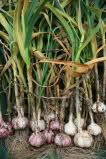 Garlic, scientifically known as Allium sativum L., is one of the most important food seasoning in the world. However, because of its many other uses, demand of this crop is continuously increasing.
Garlic, scientifically known as Allium sativum L., is one of the most important food seasoning in the world. However, because of its many other uses, demand of this crop is continuously increasing.
Aside from being an indispensable recado (ingredient), garlic is also used to cure athlete’s foot and hypertension. It is used in preparation of drugs, insecticide and explosives.
The crop is widely cultivated in the Ilocos, Southern Tagalog and central Luzon regions. All varieties grown in the Philippines are of native origin. These are batangas white, Ilocos white and Batanes white.
Garlic is dry season crop because it is harvested during the hot summer months. However, the crop is more productive during cool months when the days are shortest since bulb formation occurs at this period.
The best soil types for its cultivation are clay alluvial and sandy loam. Cool weather is needed by the crop during its early stage of growth. During ripening stage, a comparative dry soil, dry atmosphere and moderately high temperature are important.
Areas with an elevation of 8,000 to 1,500 meters above the sea level are good places for cultivation.
Land preparation. Plow and harrow the land three times to kill the weeds and to obtain fine, firm, smooth and level surface.
Prepare furrows 5 inches deep, 15 to 30 inches apart. Spread rice hull 5 cm deep evenly throughout the planting area. Irrigate the area to saturate the soil. In 2 to 3 days, the field is ready for planting.
Fertilizer usage. Apply 12-24-12 fertilizer mixture of either urea and 14-14-14 or ammonium sulphate and 14-14-14 to the field before the leveling process.
Clove preparation. Garlic clove used for planting should be prepared the afternoon before the day of planting. Carefully separate the cloves leaving those that are very small. Do not remove the thick protective scale wrapped around each clove. Soak the chosen cloves in a solution of 3 tablespoon of Malathion added to 5 gallons of water for two minutes. Cloves should be drained of the solution after planting.
Planting. The best planting time is from October to November. The weather at this time is more suitable for the early growth of the garlic.
Mark rows using string 20 cm apart from each other. Hold clove between thumb and forefinger with roots downward. Set one- fourth of the clove under the soil and press soil carefully but firmly towards the clove. Clove should be 20 cm apart from each other.
Cultivation, weeding and irrigation. Regular weeding should be done. Maintain normal soil moisture without too much water because excessive water is not good for bulb formation. Irrigate the field only when the soil really dries up.
Control of pests and diseases. The two common pests that infest garlic are mites and cutworms.
Cutworn are controlled by spraying the plants with EPN-300 at 3 tablespoons per gallon of water plus sticker. Another pesticide which can be used is Imidan 50 Wettable Powder(WP) at 3 tablespoons per gallon of water plus sticker.
Harvesting. The garlic is mature when three-fourth of the leaves have died. Uproot mature plants from the ground and arrange in windrows with leaves on to protect the bulbs from the sun. When leaves have completely dried, braid and place in trays for further curing and storage.
Market guide. Garlic, once harvested, is bought by agent-buyers from the farmers. From them the crop goes to the exporters, to the assemblers or to the retailers . From the assemblers, it goes to the wholesalers ;then to the consumers; or from the wholesalers first, then to the retailers, then finally the consumers.
Source: dost.gov.ph
Photo: cambridgebuzz.com
Where can I buy garlic seeds